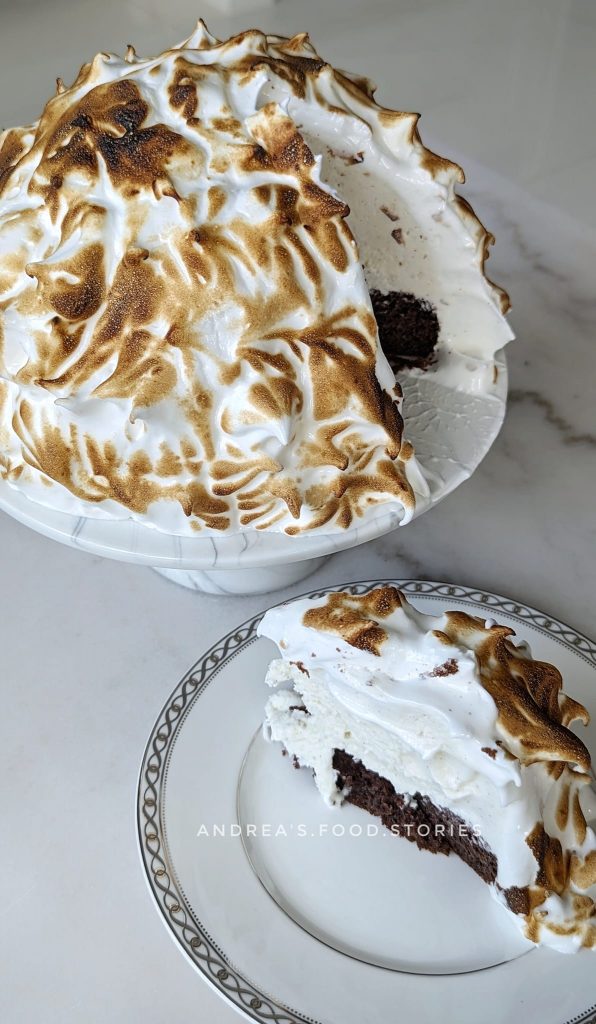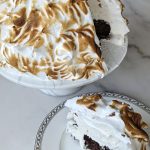
The first time I tasted Baked Alaska was at a restaurant in Hong Kong, and I instantly fell in love with it. Despite that, I never tried making it myself until recently. With Valentine’s Day around the corner, I thought it would be fun to surprise my kids and husband with a homemade Baked Alaska. They were totally surprised and loved it!
Baked Alaska is a classic dessert featuring layers of cake and ice cream, all enveloped in a beautifully browned meringue. It combines a delightful mix of textures, eye-catching presentation, and unexpected versatility. Its nostalgic charm and the excitement it sparks make it truly unique. The best part? It’s way easier to make at home than it looks.
I chose a chocolate cake base because my kids are big fans of chocolate, layered it with homemade vanilla ice cream, and whipped up the meringue using my trusty Thermomix (which is always foolproof). Baked Alaska might seem a bit intimidating at first, but it’s surprisingly simple to make. It does take some time to assemble, and you’ll need to work quickly to keep the ice cream from melting, but the results are well worth the effort!



The history of Baked Alaska is quite fascinating. The idea of insulating ice cream with meringue has been around for centuries, with the technique evolving over time. While American physicist Sir Benjamin Thompson Rumford’s discovery in 1804 about whipped egg whites as insulators is true, it’s more connected to the general use of meringue in cooking rather than directly to Baked Alaska.
The dessert became famously known as “Baked Alaska” in 1867 at Delmonico’s restaurant in New York City. The name was chosen to commemorate the United States’ purchase of Alaska from Russia, with its icy core representing Alaska’s frozen terrain and the warm meringue symbolizing the “baking” element.
People quickly fell in love with Baked Alaska as it became famous for being the grand finale of fancy meals. Its fancy look, with the meringue on top looking like snowy mountains, amazed people and showed how creative chefs could be.
Over time, Baked Alaska has seen various adaptations and presentations as chefs and home cooks explored variations of cake bases, ice cream flavours, and meringue techniques to make it their own. One notable variation involves flambeing the dessert, adding a dramatic flair to its preparation and serving. My personal experience with the restaurant in Hong Kong introduced me to this variation, igniting my love for this delightful dessert.
The Components of Baked Alaska
Cake Base: Consider using a sponge cake or genoise for a light and airy texture that complements the richness of the ice cream and meringue. When selecting or baking the cake, ensure it is sturdy enough to support the weight of the ice cream and meringue without becoming soggy.
Ice Cream Layer: Choose ice cream flavours that complement each other and the cake, such as pairing chocolate cake with vanilla ice cream or lemon cake with raspberry sorbet. Consider the texture of the ice cream; firmer ice creams will hold their shape better when frozen and sliced. To shape the ice cream layer, line a bowl with plastic wrap, fill it with softened ice cream, and freeze until firm before unmolding onto the cake.



Meringue Topping: Making meringue involves beating egg whites and sugar until stiff peaks form, creating a light and fluffy topping for the dessert. To achieve the perfect meringue texture make sure you are using clean, dry equipment and adding sugar gradually to stabilize the egg whites. Experiment with flavour variations by adding extracts such as vanilla or almond, or incorporating ingredients like cocoa powder or espresso for a twist.
The meringue also acts as an insulating layer for the ice cream by forming a barrier between the cold ice cream and the heat of the oven. The thick layer of meringue helps to slow down the transfer of heat to the ice cream, allowing it to remain frozen while the meringue browns and sets.
Assembling and Baking Baked Alaska
To assemble Baked Alaska, start by placing the cake base on a baking sheet and adding the ice cream layer on top, once it has firmed up in the freezer. Then, pipe and cover the entire dessert with meringue, ensuring it seals everything in. Next, briefly bake the dessert in a hot oven to brown the meringue without melting the ice cream, requiring precise timing to achieve a beautifully browned meringue while keeping the ice cream frozen. I personally like to use a kitchen torch, rotating it to evenly brown the meringue. It allows for more control over the browning process and can give the meringue a beautiful finish. Finally, when serving, slice through all layers with a sharp knife to reveal the delightful combination inside.
Modern Twists on Baked Alaska
To create unique variations of Baked Alaska, try different cake flavours like chocolate, lemon, or almond. For vegan or dairy-free options, use non-dairy ice creams or sorbets. Get creative with toppings such as melted chocolate drizzles or fresh fruit compote to add extra flavour and visual appeal to the dessert.
Tips and Techniques
- Ensure all components are fully prepared before assembling the Baked Alaska. This includes baking and cooling the cake, shaping and freezing the ice cream, and making the meringue.
- Opt for a sturdy cake base that can support the weight of the ice cream and meringue without becoming soggy. Sponge cake or genoise are traditional choices.
- When shaping the ice cream layer, use a bowl lined with plastic wrap to create a dome shape. Freeze the ice cream until firm before unmolding onto the cake.
- Add fresh cream of tartar to help stabilize the meringue.
- Apply the meringue generously, ensuring it completely covers the ice cream and cake. The meringue acts as insulation, protecting the ice cream from the heat of the oven.
- Use a kitchen torch for precise control over browning, or briefly place the dessert in the oven. Keep a close eye on the dessert to prevent over-browning or melting of the ice cream.
- Baked Alaska is best served immediately after browning the meringue to ensure the ice cream remains frozen.
Troubleshooting
- Soggy Cake: To prevent the cake from becoming soggy, ensure it is fully cooled before assembling the dessert. You can also lightly brush the cake with a simple syrup or liqueur for added flavour and moisture.
- Melting Ice Cream: If the ice cream starts to melt during assembly or browning, work quickly and return the dessert to the freezer if needed. Chilling the cake base before adding the ice cream can also help maintain its shape.
- Overbrowned Meringue: If the meringue browns too quickly or unevenly, shield the edges with aluminum foil while continuing to brown the center. Alternatively, use a kitchen torch for more precise control over browning.
- Meringue Deflation: To prevent the meringue from deflating after browning, add fresh cream of tartar, ensure the egg whites are whipped to stiff peaks and the sugar is fully dissolved. Avoid overmixing the meringue once the sugar is added.
- Serving Difficulty: If slicing through the meringue proves challenging, use a sharp knife dipped in hot water for clean cuts. Wipe the knife clean between slices to prevent sticking.
When it comes to desserts, few treats make an impression like Baked Alaska. It’s a delicious mix of flavours and textures that’s quite hard to resist. Once you’ve had a bite, you’ll be hooked and craving it again. Try it yourself, it’ll definitely impress your friends and family!
Baked Alaska
Ingredients
- 1 6-inch sponge cake or genoise (homemade or store-bought)
- ice cream, your choice of flavour(s)
- 4 large egg whites (room temperature)
- 1 cup granulated sugar (200g)
- 1/4 tsp cream of tartar (helps to stabilize the meringue)
- 1 tsp vanilla extract
- pinch of salt
Instructions
- If using store-bought cake, skip to step 2. If making homemade cake, bake and cool your preferred sponge cake or genoise recipe in a round cake pan. Once cooled, remove from the pan and trim to fit the size of your ice cream layer. Place the cake on a baking sheet lined with parchment paper.
- Line a round bowl with plastic wrap, leaving enough overhang to cover the ice cream later. Soften the ice cream slightly and spread it evenly into the bowl, creating a dome shape. Cover with the overhanging plastic wrap and freeze until firm, at least 4 hours or overnight.
- In a clean, dry mixing bowl, beat the egg whites, pinch of salt and cream of tartar on medium speed until soft peaks form. Gradually add the sugar, 1 tablespoon at a time, while continuing to beat on high speed. Beat until stiff, glossy peaks form. Add vanilla extract and mix until combined.
- Spread the meringue evenly over the entire dessert, ensuring it covers the ice cream and cake completely, and seals the edges. You can either spread it by hand or use a piping bag for a decorative touch.
- After assembling, use a kitchen torch to carefully brown the meringue on the outside. Move the torch evenly over the surface until the meringue is lightly golden brown.
- Once the meringue is nicely browned, use a sharp knife dipped in hot water to slice into portions. Serve immediately and enjoy the deliciousness!
